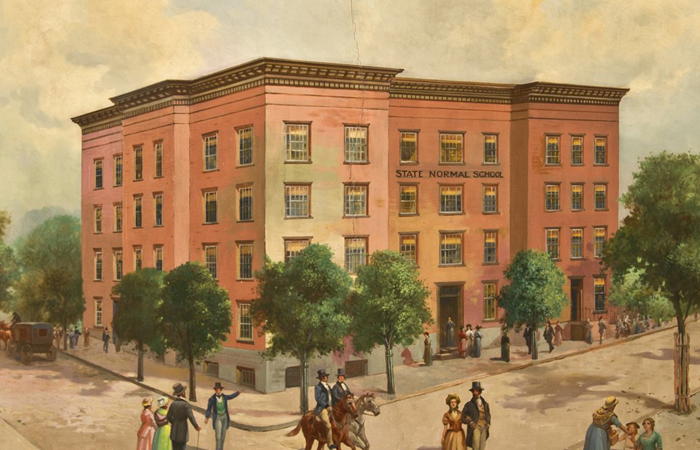The subject files feature a variety of materials that supplement Schaefer's Munitalp research documents, such as ephemera from some of his many travels, conference brochures, and weather research activities of groups not affiliated with Munitalp. This subseries also includes administrative files such as personnel information, grant writing endeavors, and budgeting, which are reflections of Schaefer's role as director of research. There are also photographs of Schaefer and colleagues, non-Skyfire research projects, travels in and out of the United States, and more generic subjects such as research equipment.
Collections : [University Archives]
University Archives
Records that document the history of the University at Albany, SUNY and its predecessor schools.
Search Constraints
Start Over You searched for: Collecting Area University Archives Remove constraint Collecting Area: University Archives Level Subseries Remove constraint Level: Subseries Date range 1932 Remove constraint Date range: <span class="single" data-blrl-single="1932">1932</span>Search Results
This subseries is devoted entirely to articles and reports from Schaefer's Munitalp years. Materials cover a range of topics including Project Skyfire, jet stream studies, cloud seeding, particle studies, and research on the relationship between environmental factors and the weather. Since this subseries is comparatively smaller than the reports and publications for General Electric, works by Schaefer and others are mixed together. The files are arranged chronologically, then alphabetically by article/report title if necessary. Folder titles note the author of each work. For Schaefer's writings, the archivist noted if there is a manuscript included with the published copy.
The correspondence in this subseries is a mix of letters received by Schaefer as well as carbon copies of letters sent by him or his secretary, Alice Klopfer. The archivist believes that the filing system used in this subseries was created by Ms. Klopfer and has been preserved accordingly. Most folders are titled by the name of the person or company for whom Schaefer was consulting, but there are also files titled simply by letter of the alphabet—these contain correspondence from sources that were not numerous enough to warrant their own folders, and are identified within each folder by subject.
The documents in this subseries are arranged by name of the organization, institution, or person with whom Schaefer was consulting, followed by a brief indication of the topic(s) within. Schaefer consulted for a wide variety of places, including Boeing; Philip Morris; Arthur D. Little, Inc.; the University of Nevada; Rensselaer Polytechnic Institute and many more. Files include a variety of items such as meeting minutes and reports from organizations Schaefer was working with, company brochures and newsletters, itineraries and vouchers from Schaefer's extensive travels, contract agreements, and correspondence that was not already filed with the letters in subseries #1.
In addition to serving on the Education Committee of the American Meteorological Society, Schaefer also served on the general council of the AMS. This subseries features documents on the AMS educational films project, correspondence, a few AMS bulletins, and some programs from annual AMS meetings. Although the files do not directly relate to the founding of the Loomis School/NSI, the AMS was responsible for the founding of the Atmospheric Sciences Program at the Loomis School in 1959, and the documentation of educational programs found in this subseries foreshadows the creation of those summer sessions.
As director of the Loomis School activities, and ultimately as director of research at the Atmospheric Sciences Research Center at the State University of New York, Albany, Schaefer kept records pertaining to the operation of the program. There are many correspondence files; some are between Schaefer and colleagues while others are between Schaefer and the students from the summer program. Numerous students kept in touch with Schaefer well beyond the years that they participated in the Atmospheric Sciences Program, and many of them became successful professionals in their own right.
Schaefer retained many notebooks kept by the students who participated in the Atmospheric Sciences Program, as well as some of their final papers that detail the projects they worked on for eight weeks. Encouraged by Schaefer to do self-directed experiments, the students kept logs of observations and measurements to aid them in their final reports to staff and peers. A few also sketched illustrations to accompany their notes. Some of the papers in this subseries are final reports of the students' experiments while others are thoughts and reflections on the experience as a whole.
This last subseries contains official reports by Schaefer on the activities of the Atmospheric Sciences Program and records its progress as it transforms into the Natural Sciences Institute at the State University of New York, Albany. Some of the reports cover the summer program as a whole, while others focus specifically on field station issues. There are also articles published by current and former students of the program as well as some articles published by Schaefer himself.
The majority of the administrative files consist of correspondence; as director of research and then overall director of the ASRC, Schaefer was in constant contact with administrators of SUNY Albany, local colleagues, and other professionals in the field. There are also documents dealing with budget issues, grant applications, conferences, and operation of the N.S.I. field stations.
Schaefer saw research opportunities via the ASRC that promised to have national and even international implications as environmental concerns became more public in the 1960s and 1970s. He was engaged frequently to speak about his research, both to other professionals and to "everyday" people who might be interested in learning more about issues like acid rain or solar energy. He also participated on committees and commissions who were given the responsibility of investigating scientific dilemmas of the day and presenting findings to the government. This subseries contains materials from those speaking engagements, trips, and committees.
